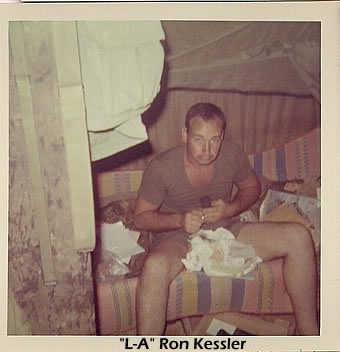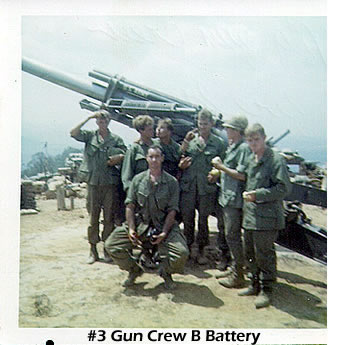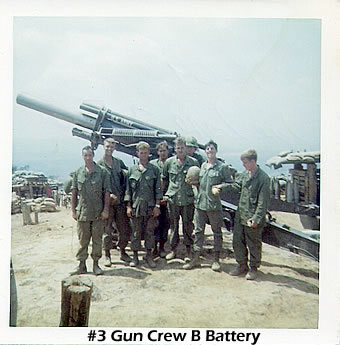 One of the important things that I taught him I had learned by experience. When firing with a Charge 7 the trails on the gun have a tendency to jump off the ground. In doing so, the trails also attempt to close. The AG position requires him to stand on the inside of the right trail with his legs against the trail. If the AG does not bend his knees immediately after pulling the lanyard, the trail will slap him in the back of the knees, or legs depending on the AG's height, and push him forward. Being pushed forward gives the AG a meeting with the recoil of the gun which can be quite dangerous. One of the important things that I taught him I had learned by experience. When firing with a Charge 7 the trails on the gun have a tendency to jump off the ground. In doing so, the trails also attempt to close. The AG position requires him to stand on the inside of the right trail with his legs against the trail. If the AG does not bend his knees immediately after pulling the lanyard, the trail will slap him in the back of the knees, or legs depending on the AG's height, and push him forward. Being pushed forward gives the AG a meeting with the recoil of the gun which can be quite dangerous.
Well, as I said, Cisco grasped what he was supposed to do (and not do) and he did so quickly. In fact, so well and quickly did he learn the AG job that after a few weeks he was going out with the crew on a fire mission without my assistance. Therefore when the cry of "FIRE MISSION" came in the wee hours of the morning, I would grunt, roll over and go back to sleep (I only did this when I had less than 30 days left in Country ad was officially "Short"). One of the 'newbies' wanted to know why I was staying in my bunk sleeping while he was struggling out of our rat infested hooch in the middle of the night to engage the enemy in combat (or most likely to fire H & I's). In answer to his question I just held up my Short Timer Calendar.
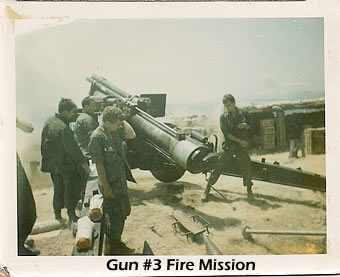 One of the jobs that must be done while firing the M114A1 is to swab the tube. Even when there was not enough water available to take a whores bath, we had to have enough water to swab the tube. The tools for doing so was a bucket (Bucket, Metal, M-whatever) and a piece of wood akin to a broom handle with rags affixed to the end of it. If the tube was not swabbed, burning powder residue from previous round(s) that had been fired may cause the next bag of powder put in the tube to ignite prematurely. By ignite I mean it would explode. One of the jobs that must be done while firing the M114A1 is to swab the tube. Even when there was not enough water available to take a whores bath, we had to have enough water to swab the tube. The tools for doing so was a bucket (Bucket, Metal, M-whatever) and a piece of wood akin to a broom handle with rags affixed to the end of it. If the tube was not swabbed, burning powder residue from previous round(s) that had been fired may cause the next bag of powder put in the tube to ignite prematurely. By ignite I mean it would explode.
While training Cisco, I instilled in him that the tube MUST be swabbed at least after every 3 rounds if not sooner. I knew that he understood the importance of this because I observed him diligently telling the 'gun bunny' in charge of the swab stick to swab before a powder charge was put in the tube.
I left Firebase 6 on May 9, 1969, knowing that my replacement, Cisco, was properly trained. Perhaps not trained by the M114A1 Manual, but trained to safely and efficiently do the AG job.
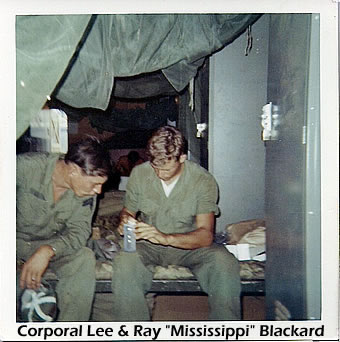 I sat on my duffel bag outside our hooch most of the afternoon waiting for a chopper to become available to fetch me to base camp. Finally a LOCH landed and someone hollered at me to get my a** to the chopper pad right now. I never got a chance to say goodbye to the guys that I had shared a hooch with and spent many sweat soaked, exhausted hours with on the 'Pig'. They, like the intelligent artillerymen that they were, spent the afternoon out of the hot sun inside the hooch sleeping or reading. I sat on my duffel bag outside our hooch most of the afternoon waiting for a chopper to become available to fetch me to base camp. Finally a LOCH landed and someone hollered at me to get my a** to the chopper pad right now. I never got a chance to say goodbye to the guys that I had shared a hooch with and spent many sweat soaked, exhausted hours with on the 'Pig'. They, like the intelligent artillerymen that they were, spent the afternoon out of the hot sun inside the hooch sleeping or reading.
When I scrambled in the chopper, I saw that the pilot was a young warrant officer who looked like he should be in high school. He watched me buckle up and then turned and started the chopper for the ride of my life. On the way to Pleiku, he was going up and down and zig-zagging, all the while observing me in the rear view mirror. I guess he thought I would be frightened by his erratic flight. It was the most exhilarating chopper ride that I ever had.
May 10, 1969: Davis, Heard, Phillips, Autry (recent FBSE 6 tenants) and I were in the transient barracks on Artillery Hill. We were between processing out chores, relaxing and BS'ing. Someone came in and asked if we had heard about the gun exploding on Firebase 6? If I remember correctly, Bill Davis and I went to supply to see if we could get more information. We eventually learned that it was Gun #3 that had blown. However, we didn't get any details as t the why and what. I don't remember if I learned of Cisco's death at that time.
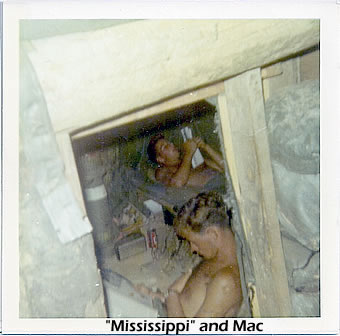 We left Pleiku from the Air Force base next to Artillery Hill and flew t Cam Rahn Bay to await the "Freedom Bird" that would take us to the "World". All the while, I was thinking about the #3 Gun Crew and wondering what happened and who was hurt and what caused the explosion. We left Pleiku from the Air Force base next to Artillery Hill and flew t Cam Rahn Bay to await the "Freedom Bird" that would take us to the "World". All the while, I was thinking about the #3 Gun Crew and wondering what happened and who was hurt and what caused the explosion.
After a 30 day leave, I drove to Fort Lewis Washington. The one place I had requested not to be stationed on my "Dream Sheet". We had received our "Dream Sheets" about 60 days or so prior to leaving our tropical vacation. On the sheet we wrote down three choices for Stateside duty. At the bottom of my sheet I made the mistake of writing "anyplace but Ft. Lewis". I had taken basic training there in the rain and snow and hated the place.
Davis and Phillips also received orders for Ft. Lewis. After we were there a few weeks we somehow learned that one of the crewmen from Gun #3 was in Madigan General Hospital on post. the three of us visited him but didn't get much information from him. One of his legs and one arm had been sheared off by shrapnel when the gun exploded. He stared at the wall over our shoulders most of the time we were in the hospital room with him.
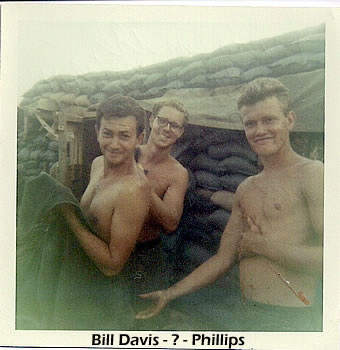 Sometime later I received a letter from another Gun #3 crewman. I got the letter a few days before our battalion shipped out to Germany to play NATO War Games. That is when I learned the gun had blown because the tube had not been swabbed. I was perplexed. Knowing that the crew knew how important swabbing the tube was, I wondered why it wasn't done. Sometime later I received a letter from another Gun #3 crewman. I got the letter a few days before our battalion shipped out to Germany to play NATO War Games. That is when I learned the gun had blown because the tube had not been swabbed. I was perplexed. Knowing that the crew knew how important swabbing the tube was, I wondered why it wasn't done.
After 41 years of wondering, I now know why the tube was not swabbed. I was told by one of the Gun #3 crewmembers that they were ordered not to stop firing. This order caused the death of one, the loss of limbs of two and the concussion and lifetime mental anguish of others.
Iwon't go into the details of who gave the order that caused this mayhem. I'll just keep the memory of Cisco as the quiet, shy kid from Texas and the other Gun #3 Artillerymen whom I sweated, toiled and laughed with.
Larry "Jeff" Jeffers
May 14, 2011
|

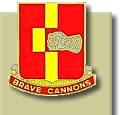

 One of the important things that I taught him I had learned by experience. When firing with a Charge 7 the trails on the gun have a tendency to jump off the ground. In doing so, the trails also attempt to close. The AG position requires him to stand on the inside of the right trail with his legs against the trail. If the AG does not bend his knees immediately after pulling the lanyard, the trail will slap him in the back of the knees, or legs depending on the AG's height, and push him forward. Being pushed forward gives the AG a meeting with the recoil of the gun which can be quite dangerous.
One of the important things that I taught him I had learned by experience. When firing with a Charge 7 the trails on the gun have a tendency to jump off the ground. In doing so, the trails also attempt to close. The AG position requires him to stand on the inside of the right trail with his legs against the trail. If the AG does not bend his knees immediately after pulling the lanyard, the trail will slap him in the back of the knees, or legs depending on the AG's height, and push him forward. Being pushed forward gives the AG a meeting with the recoil of the gun which can be quite dangerous. One of the jobs that must be done while firing the M114A1 is to swab the tube. Even when there was not enough water available to take a whores bath, we had to have enough water to swab the tube. The tools for doing so was a bucket (Bucket, Metal, M-whatever) and a piece of wood akin to a broom handle with rags affixed to the end of it. If the tube was not swabbed, burning powder residue from previous round(s) that had been fired may cause the next bag of powder put in the tube to ignite prematurely. By ignite I mean it would explode.
One of the jobs that must be done while firing the M114A1 is to swab the tube. Even when there was not enough water available to take a whores bath, we had to have enough water to swab the tube. The tools for doing so was a bucket (Bucket, Metal, M-whatever) and a piece of wood akin to a broom handle with rags affixed to the end of it. If the tube was not swabbed, burning powder residue from previous round(s) that had been fired may cause the next bag of powder put in the tube to ignite prematurely. By ignite I mean it would explode. I sat on my duffel bag outside our hooch most of the afternoon waiting for a chopper to become available to fetch me to base camp. Finally a LOCH landed and someone hollered at me to get my a** to the chopper pad right now. I never got a chance to say goodbye to the guys that I had shared a hooch with and spent many sweat soaked, exhausted hours with on the 'Pig'. They, like the intelligent artillerymen that they were, spent the afternoon out of the hot sun inside the hooch sleeping or reading.
I sat on my duffel bag outside our hooch most of the afternoon waiting for a chopper to become available to fetch me to base camp. Finally a LOCH landed and someone hollered at me to get my a** to the chopper pad right now. I never got a chance to say goodbye to the guys that I had shared a hooch with and spent many sweat soaked, exhausted hours with on the 'Pig'. They, like the intelligent artillerymen that they were, spent the afternoon out of the hot sun inside the hooch sleeping or reading. We left Pleiku from the Air Force base next to Artillery Hill and flew t Cam Rahn Bay to await the "Freedom Bird" that would take us to the "World". All the while, I was thinking about the #3 Gun Crew and wondering what happened and who was hurt and what caused the explosion.
We left Pleiku from the Air Force base next to Artillery Hill and flew t Cam Rahn Bay to await the "Freedom Bird" that would take us to the "World". All the while, I was thinking about the #3 Gun Crew and wondering what happened and who was hurt and what caused the explosion. Sometime later I received a letter from another Gun #3 crewman. I got the letter a few days before our battalion shipped out to Germany to play NATO War Games. That is when I learned the gun had blown because the tube had not been swabbed. I was perplexed. Knowing that the crew knew how important swabbing the tube was, I wondered why it wasn't done.
Sometime later I received a letter from another Gun #3 crewman. I got the letter a few days before our battalion shipped out to Germany to play NATO War Games. That is when I learned the gun had blown because the tube had not been swabbed. I was perplexed. Knowing that the crew knew how important swabbing the tube was, I wondered why it wasn't done.